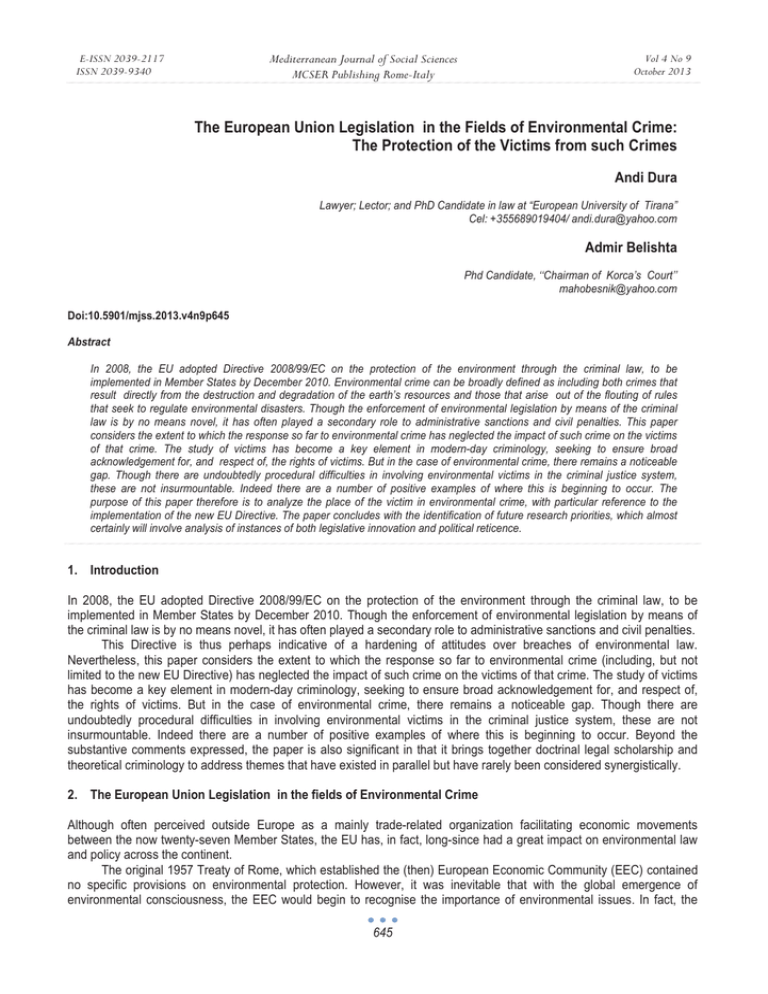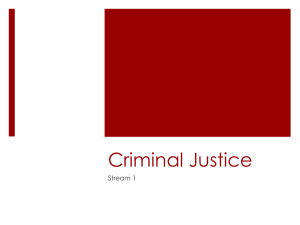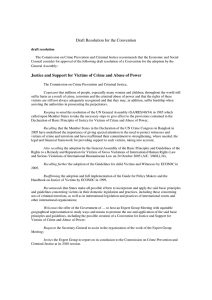The European Union Legislation in the Fields of Environmental... The Protection of the Victims from such Crimes
advertisement

Mediterranean Journal of Social Sciences MCSER Publishing Rome-Italy E-ISSN 2039-2117 ISSN 2039-9340 Vol 4 No 9 October 2013 The European Union Legislation in the Fields of Environmental Crime: The Protection of the Victims from such Crimes Andi Dura Lawyer; Lector; and PhD Candidate in law at “European University of Tirana” Cel: +355689019404/ andi.dura@yahoo.com Admir Belishta Phd Candidate, ‘‘Chairman of Korca’s Court’’ mahobesnik@yahoo.com Doi:10.5901/mjss.2013.v4n9p645 Abstract In 2008, the EU adopted Directive 2008/99/EC on the protection of the environment through the criminal law, to be implemented in Member States by December 2010. Environmental crime can be broadly defined as including both crimes that result directly from the destruction and degradation of the earth’s resources and those that arise out of the flouting of rules that seek to regulate environmental disasters. Though the enforcement of environmental legislation by means of the criminal law is by no means novel, it has often played a secondary role to administrative sanctions and civil penalties. This paper considers the extent to which the response so far to environmental crime has neglected the impact of such crime on the victims of that crime. The study of victims has become a key element in modern-day criminology, seeking to ensure broad acknowledgement for, and respect of, the rights of victims. But in the case of environmental crime, there remains a noticeable gap. Though there are undoubtedly procedural difficulties in involving environmental victims in the criminal justice system, these are not insurmountable. Indeed there are a number of positive examples of where this is beginning to occur. The purpose of this paper therefore is to analyze the place of the victim in environmental crime, with particular reference to the implementation of the new EU Directive. The paper concludes with the identification of future research priorities, which almost certainly will involve analysis of instances of both legislative innovation and political reticence. 1. Introduction In 2008, the EU adopted Directive 2008/99/EC on the protection of the environment through the criminal law, to be implemented in Member States by December 2010. Though the enforcement of environmental legislation by means of the criminal law is by no means novel, it has often played a secondary role to administrative sanctions and civil penalties. This Directive is thus perhaps indicative of a hardening of attitudes over breaches of environmental law. Nevertheless, this paper considers the extent to which the response so far to environmental crime (including, but not limited to the new EU Directive) has neglected the impact of such crime on the victims of that crime. The study of victims has become a key element in modern-day criminology, seeking to ensure broad acknowledgement for, and respect of, the rights of victims. But in the case of environmental crime, there remains a noticeable gap. Though there are undoubtedly procedural difficulties in involving environmental victims in the criminal justice system, these are not insurmountable. Indeed there are a number of positive examples of where this is beginning to occur. Beyond the substantive comments expressed, the paper is also significant in that it brings together doctrinal legal scholarship and theoretical criminology to address themes that have existed in parallel but have rarely been considered synergistically. 2. The European Union Legislation in the fields of Environmental Crime Although often perceived outside Europe as a mainly trade-related organization facilitating economic movements between the now twenty-seven Member States, the EU has, in fact, long-since had a great impact on environmental law and policy across the continent. The original 1957 Treaty of Rome, which established the (then) European Economic Community (EEC) contained no specific provisions on environmental protection. However, it was inevitable that with the global emergence of environmental consciousness, the EEC would begin to recognise the importance of environmental issues. In fact, the 645 E-ISSN 2039-2117 ISSN 2039-9340 Mediterranean Journal of Social Sciences MCSER Publishing Rome-Italy Vol 4 No 9 October 2013 1987 Single European Act was the first treaty to give a legal basis to the protection of the environment as an explicit competence within the EU. From 1973 onwards the process of European integration incorporated the need for greater coordinated activity via successive Environmental Action Programmes, which served as the principal guidelines for legislative action. Since the Single European Act, the commitment to protecting the environment has been strengthened in every major Treaty revision since. The 1992 Treaty on European Union was especially important insofar as it included an express reference to the precautionary principle and the objective of ‘aiming at a high level of protection’ of the environment within its scope. The 1998 Treaty of Amsterdam provided some clarity by changing (the then) article 2 so as to set as objectives to: promote throughout the Community a harmonious, balanced and sustainable development of economic activities, and sustainable and non-inflationary growth…a high level of protection and improvement of the quality of the environment. A further treaty article reinforced this by stating that: Environmental protection requirements must be integrated into the definition and implementation of the Community policies and activities in particular with a view to promoting sustainable development. The protection of the environment – and sustainable development – continues to take pride of place in the Treaty following the revisions brought about by the 2007 Treaty of Lisbon, underlining its status at the heart of the legal and political principles of the EU, both domestically and globally. Secondary European law, through the adoption of regulations and directives, has been used to give substantive effect to the Treaty competence on environmental protection. As the hallmarks of EU governance, regulations and directives are legal instruments which, though created at the supranational level through a complex institutional process, take effect at the national level. In particular, they have been used to harmonise standards and create the regulatory framework for environmental protection in the EU, as well as permitting individual enforcement of their provisions at the domestic level in certain instances. There are more than 200 regulations and directives explicitly concerning the environment in force in the EU, concerning, inter alia, the pollution of water and the air, waste management, biotechnology, nature conservation and nuclear safety.The protection of the environment can therefore rightly be seen as one of the most extensive areas of legislative activity within the EU over the past twenty years. Though the principal focus of this paper is upon the 2008 Directive and, more significantly, what we believe it is lacking – a connection with the rights of victims – it should be acknowledged that the Directive cannot be considered alone but in the broader context of other attempts to use the criminal law to ensure more effective enforcement of environmental law. Of course, using the criminal law to enforce environmental provisions has not been the traditional method of many States, which have been keen, in many instances, to redress environmental harm through the imposition of administrative sanctions. The 2008 Directive is, in some ways, a modest document, though its impact is likely to be more keenly felt. Moreover, as the European Court of Justice noted in 2005 in judicial proceedings brought over the correct legislative base for the Directive, criminal law has a clear role to play in environmental matters: As a general rule, neither criminal law nor the rules of criminal procedure fall within the Community’s competence…the last-mentioned finding does not prevent the Community legislature, when the application of effective, proportionate and dissuasive criminal penalties by the competent national authorities is an essential measure for combating serious environmental offences, from taking measures which relate to the criminal law of the Member States which it considers necessary in order to ensensure that the rules which it lays down on environmental protection are fully effective. The Directive requires Member States to ‘criminalise’ certain defined breaches of EU environmental law. Previously, Member States had the sole responsibility to determine the appropriate sanction. As studies for the European Commission on this issue make clear, there was high variability in the both the nature (criminal, civil and administrative) and severity of penalties and sanctions imposed. The range of acts which now require the imposition of criminal law include, inter alia, instances of pollution, the generation, disposal and other activities related to hazardous waste, nuclear materials and radioactive waste and the operation of a plant in which a dangerous activity is carried out, but in all cases only where they ‘cause or are likely to cause death or serious injury to any person or substantial damage to the quality of air, the quality of soil or the quality of water, or to animals or plants’; the illegal shipment of hazardous waste; the destruction of wild fauna and flora and habitat; trading in protected specimens of wild fauna and flora or parts or derivates thereof; and the various production, 646 E-ISSN 2039-2117 ISSN 2039-9340 Mediterranean Journal of Social Sciences MCSER Publishing Rome-Italy Vol 4 No 9 October 2013 transit and marketing stages involving the sale of ozone-depleting substances. The final Directive is a pale reflection of previous draft versions, which were much more prescriptive in the levels of criminal penalty to apply. Of particular interest was draft article 5, paragraph 5: The criminal sanctions provided for in this article may be accompanied by other sanctions or measures, in particular: a. the disqualification of a natural person from engaging in an activity requiring official authorization or approval, or founding, managing or directing a company or a foundation, where the facts having led to his conviction show a high risk that the same kind of criminal activity may be pursued again; b. the publication of the judicial decision relating to the conviction or any sanctions or measures applied; c. the obligation to reinstate the environment. Though the exclusion of this draft article does not now prevent Member States incorporating such ideas within their own domestic law at the time of implementation (with some Member States already likely to include such provisions) its absence is likely to ensure less uniformity on such matters ancillary to the principal penalty. Significantly, this is as close as the Directive ever came, it would appear, to addressing the interests of victims. On the other hand, the 2004 EU Environmental Liability Directive – which must to some degree be considered the ‘sister’ directive to the 2008 Directive in this regard premised as it is upon the administrative, rather than criminal, liability of operators – includes a key role for those affected by environmental harm. As article 12 (entitled ‘request for action’) and article 13 (‘review procedures’) of that Directive state: Article 12 1. Natural or legal persons: a) affected or likely to be affected by environmental damage or b) having a sufficient interest in environmental decision making relating to the damage or, alternatively, c) alleging the impairment of a right, where administrative procedural law of a Member State requires this as a precondition, shall be entitled to submit to the competent authority any observations relating to instances of environmental damage or an imminent threat of such damage of which they are aware and shall be entitled to request the competent authority to take action under this Directive. What constitutes a "sufficient interest" and "impairment of a right" shall be determined by the Member States. To this end, the interest of any non-governmental organisation promoting environmental protection and meeting any requirements under national law shall be deemed sufficient for the purpose of subparagraph (b). Such organisations shall also be deemed to have rights capable of being impaired for the purpose of subparagraph (c). Article 13 1. The persons referred to in Article 12(1) shall have access to a court or other independent and impartial public body competent to review the procedural andsubstantive legality of the , acts or failure to act of the competent authority under this Directive. However, though significant and reflective of broader developments in international environmental citizenship, similar ideas remain noticeably absent from many of the other (usually older) international and domestic provisions on civil and administrative liability for environmental harm. And though the specific provisions of the Environmental Liability Directive can perhaps be seen to be more readily influenced by – in a weaker form – article 18 of the earlier 1993 Council of Europe (‘Lugano’) Convention on Civil Liability for Damage Resulting from Activities Dangerous to the Environment,33 this 1993 Convention is itself not in force and is considered aspirational in many respects, including on matters of participation. Much more importantly for the purposes of this paper, the 1998 Council of Europe Convention contains, at article 11, a not dissimilar provision – though obviously of increased pertinence due to that Treaty’s focus on criminal law enforcement. It reads: Each Party may, at any time, in a declaration addressed to the Secretary General of the Council of Europe, declare that it will, in accordance with domestic law, grant any group, foundation or association which, according to its statutes, aims at the protection of the environment, the right to participate in criminal proceedings concerning offences established in accordance with this Convention. This has the potential to be a ground-breaking article, raising the very real possibility of opening up environmental criminal proceedings to wider participation, recognising however that the ‘right to participate’ covers a breadth of possibilities, ranging from the nominal to the much more substantive. Edwards, for instance, has labelled participation as ‘a comfortably pleasing platitude’, which is rhetorically powerful but conceptually abstract. Interestingly, article 11 of the 647 E-ISSN 2039-2117 ISSN 2039-9340 Mediterranean Journal of Social Sciences MCSER Publishing Rome-Italy Vol 4 No 9 October 2013 1998 Convention is carefully worded to remove any sense of the individual victim. Nevertheless, its inclusion is an important indication of changing attitudes. No longer is the State viewed as the sole trustee of the public good. As the explanatory report to the Convention notes, ‘the main reason for allowing NGOs access to environmental proceedings is that criminal law in the environmental field protects interests of a highly collective nature, in view of the fact that the various forms of pollution potentially affect the interest not only of single individuals, but also of groups of persons’. It is our contention that, given the widespread development of victims’ rights in other areas of criminal law coupled with the pervasive and long-lasting impacts of environmental crimes (and indeed what might be referred as ‘quasicrimes’) on individuals, it is becoming increasingly difficult to legitimately exclude such victims from the ambit of instruments, such as the 2008 Directive. It has been noted above that the International Law Commission in its 2006 Draft Principles of Allocation of Loss has drawn links between the definition of the ‘victim’ and the notion of legal standing. Legal standing is in fact at the heart of most of the debates concerning victims’ rights because, in recent history, victims have lacked party status in most domestic criminal justice systems, both in Europe and elsewhere. As a consequence of this legal reality, it is the State which acquires the rights of individual victims, effectively forcing those affected by crimes and other social misfortunes to take a subsidiary role in proceedings. This was famously captured by Christie who argued that the State effectively ‘steals’ conflicts from their rightful owners, namely the victim and the accused. This traditional argument is given fresh impetus by the issue of environmental crimes, where the victims include not only individuals and their physical or emotional health, but the social, cultural and economic life of entire communities. Nevertheless, the rights of victims have increasingly secured global recognition. The United Nations General Assembly, for instance, adopted the 1985 UN Declaration of Basic Principles of Justice for Victims of Crime and Abuse of Power, which has remained the most wide-ranging and influential document on the issue of victims’ rights at theinternational level. The declaration speaks of victims being afforded access to justice, fair treatment and of compassion and respect for the dignity of victims. The instrument also makes reference to victims being informed about their role and about the scope, timing, and progress of proceedings, as well as the disposal of their case. The Declaration further maintains that victims should be guaranteed assistance from the criminal justice system (including information that such assistance is available), as well as formal and/or informal procedures providing them with redress, restitution and compensation for wrongs suffered. The document also has provisions protecting victims from unnecessary delay or inconvenience within the criminal justice system and ensuring their concerns are considered. Perhaps most significant for the present paper is its definition of ‘victims of abuse of power’: "Victims" means persons who, individually or collectively, have suffered harm, including physical or mental injury, emotional suffering, economic loss or substantial impairment of their fundamental rights, through acts or omissions that do not yet constitute violations of national criminal laws but of internationally recognized norms relating to human rights. It will be noted that this definition expressly includes activities which are not ‘illegal’ in the strict sense: thus encompassing the grey legal areas in which environmental destructive activities sometimes fall. Williams has argued that the definition of such victims utilised by the 1985 Declaration can serve as a useful starting point for ascribing rights to environmental victims. 3. Conclusion The purpose of this paper has been to consider the role of criminal law in the enforcement of environmental law and to acknowledge that the increased recognition of its utility is something to be generally welcomed. To that extent the 2008 Directive is a step forward. Nonetheless, by failing to incorporate the rights of victims within this progressive development, the Directive has missed an important opportunity. This is especially noticeable not only because victims of crime are gradually being supported by the criminal justice process more generally but also, as recent developments in environmental law itself have shown, citizen participation is now considered an essential element for effective regulation. It thus seems regrettable that when these two lines of enquiry intersected within the EU – in the 2008 Directive – the opportunity to advance this mutual agenda was neglected. Such an outcome was not inevitable. As both the 1998 Council of Europe Convention and the US Crime Victims’ Rights Act demonstrate, it is wholly 648 E-ISSN 2039-2117 ISSN 2039-9340 Mediterranean Journal of Social Sciences MCSER Publishing Rome-Italy Vol 4 No 9 October 2013 appropriate to combine environmental crime with allowing victims to participate in the criminal justice process. It is to be hoped that the EU will take the opportunity to remedy this deficiency in due course, possibly with the likely adoption of a new Directive on victims’ rights in 2012. That is, however, only the beginning of the discussion; one then moves to consider just who is a victim within thiscontext, what (procedural) rights they should have and how to give best effect to them. This paper is also significant, because of its interdisciplinarity, bringing together doctrinal legal scholarship and theoretical criminology to address themes that have existed in parallel but have rarely been considered synergistically. Such an approach – which should also incorporate empirical studies – seems to be the most obvious way forward when thinking about this issue. Such research would hopefully not only reveal instances of legislative innovation – though equally likely to show examples of political reticence – but of greater significance, it will allow to attempt to develop a more principled understanding as to how might think about, and bring together, these two welfarist agendas of victims’ rights and environmental protection, for the benefit of both. References Mitsilegas, V., EU Criminal Law. Hart Publishing. 2009 and Fletcher, M; Loof, R and Gilmore, B. (eds) EU Criminal Law and Justice. Edward Elgar. 2008. Wolf, S. and Stanley, N. (2010, 5th ed) Wolf and Stanley on Environmental Law. Cavendish Publishing, 5th edition, 2010, p.69. Birnie, P., Boyle, A. and Redgwell, C., International Law and the Environment. Oxford. 2009. 3rd edn. Holder, J. and Lee, M., Environmental Protection, Law and Policy. Cambridge. 2007. 2nd edn, p.382 Hayman, G. and Brack, D., International Environmental Crime: The Nature and Control of Environmental Black Markets. Royal Institute of International Affairs. 2002. Kramer, L., EC Environmental Law. Sweet & Maxwell. 2006. 6th rev edn. Mitsilegas, V , EU Criminal Law, Hart Publishing, 2009. White, R., Crimes Against Nature: Environmental criminology and ecological justice. Willan Publishing. 2008. Report for the EU Commission by Huglo Lepage & Partners, Study on Environmental Crime in the 27 Member States, 2007 accessible at: http://ec.europa.eu/environment/legal/crime/pdf/report_environmental_crime.pdf (last accessed: January 2011). Directive 2004/35/EC OJ L 143/56 (30.4.2004) and Directive 2008/99/EC. Council Regulation (EEC) No 1210/90 of 7 May 1990 on the establishment of the European Environment Agency and the European Environment Information and Observation Network. 649







